I am a big fan of midTweeters. My favourite to date has been the EnABLed Markaudio Alpair 7.3. I may have the last stock on th planet. The Pluvia 7HD is largely derived from the A7.3.
You will have to do your own EnABLing these days.
Depending on your needs, competitive with the very good Scan (but better top), and about half the price are teh FF85wk (there are some simple mods that ameriolate the rough edges) or Markaudio Alpair 5.3. On a budget the CHN-50 gets amazingly close to the A5.3, and at the high end the MAOP 5.
dave
You will have to do your own EnABLing these days.
Depending on your needs, competitive with the very good Scan (but better top), and about half the price are teh FF85wk (there are some simple mods that ameriolate the rough edges) or Markaudio Alpair 5.3. On a budget the CHN-50 gets amazingly close to the A5.3, and at the high end the MAOP 5.
dave
@mayhem13 Can you say more about your idea ?
For me your question is interesting to develop because things are not so simple 😉
I can give you a list of good mid-range at different price to 20$ to 400$ I have used and they work well.
I built several tree ways and I had some disappointing results. The problem are very diverse
1. I hadn't enough skills to understand how to do it right
2. The sound of the mid-range is not so good to my ears, where you use glass-fiber mid-range or a plastic with paper woofer.
3. Bad design
etc.
When you look a 3/4... ways you have this curve :

Triade speaker
The mid-range fills a hole between the woofer and the tweeter ! In this case the slope are 24db/octave. You never listen to a mid-range, but a marriage of the driver. For me the problem is not the mid-range sound but how to you marry the mid-range 🙂
An other marriage, my own project : W22NX001+MU10RB+27DXT 800Hz-3500HZ LR2, not so easy to design but works well.

Notes :
- With a mid-range I have the flattest response curve in my loudspeaker, better than a 2 ways where you can have serious issues in the frequency response 😉
For me your question is interesting to develop because things are not so simple 😉
I can give you a list of good mid-range at different price to 20$ to 400$ I have used and they work well.
I built several tree ways and I had some disappointing results. The problem are very diverse
1. I hadn't enough skills to understand how to do it right
2. The sound of the mid-range is not so good to my ears, where you use glass-fiber mid-range or a plastic with paper woofer.
3. Bad design
etc.
When you look a 3/4... ways you have this curve :
Triade speaker
The mid-range fills a hole between the woofer and the tweeter ! In this case the slope are 24db/octave. You never listen to a mid-range, but a marriage of the driver. For me the problem is not the mid-range sound but how to you marry the mid-range 🙂
An other marriage, my own project : W22NX001+MU10RB+27DXT 800Hz-3500HZ LR2, not so easy to design but works well.
Notes :
- With a mid-range I have the flattest response curve in my loudspeaker, better than a 2 ways where you can have serious issues in the frequency response 😉
- A 4" and a 5" for me are very different in crossover point.
- The problem with mid-range are power handling, when you play loud, the mid-range must not yelling.
Hello @jerome69
I am a reader of the website justdiyit.com.
I encourage you to explore the capabilities of VituixCAD2. It is very powerful and I'm learning new things everyday from this fine software.
Consider taking polar measurements with minimum 10 degrees measurements. Depending on whether you use REW , CLIO, ARTA, or even SoundEasy
Please also consider changing the slope between the MF and HF from LR4 to a shallower slope eg. LR2, as you may an improvement in power response and in-room response above the Schroeder frequencies.
eg.


Both look almost identical...
but here are the individual driver responses- acoustic LR4 between MF and HF:

Acoustic LR2 between MF and HF:

Here are clickable comparisons for horizontal polar responses:
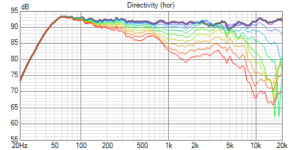
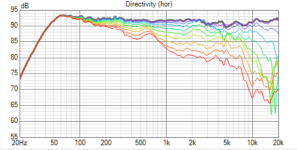
and "spinorama"
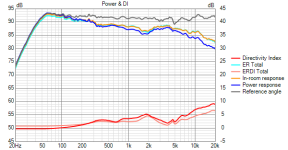
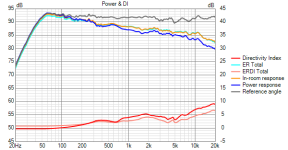
the clue to solving your challenge came from the
Horizontal responses of the otherwise fine Triade speaker, with peaking at 3Khz for 60 degrees off axis.
I am a reader of the website justdiyit.com.
I encourage you to explore the capabilities of VituixCAD2. It is very powerful and I'm learning new things everyday from this fine software.
Consider taking polar measurements with minimum 10 degrees measurements. Depending on whether you use REW , CLIO, ARTA, or even SoundEasy
Please also consider changing the slope between the MF and HF from LR4 to a shallower slope eg. LR2, as you may an improvement in power response and in-room response above the Schroeder frequencies.
eg.
Both look almost identical...
but here are the individual driver responses- acoustic LR4 between MF and HF:
Acoustic LR2 between MF and HF:
Here are clickable comparisons for horizontal polar responses:


and "spinorama"


the clue to solving your challenge came from the
Horizontal responses of the otherwise fine Triade speaker, with peaking at 3Khz for 60 degrees off axis.
Last edited:
Yes my tools are very old, I should go to VituixCAD2. I tested it, it was working but not dive further. Very interesting curves 😉. I have the combination LR4-LR2 in one of my design. The little issue it is easier to do LR2-LR4, because LR2 is sensitive to acoustics center, it is harder, not impossible, to align emissive center of the tweeter and the midrange.
To stay in the subject the 4", you have to place the driver on the front panel to avoid bad diffraction effects, align it with the tweeter as LR2 give better dispersion results. I wonder if intrinsic performance of the midrange is what you are listen to or if you are listen to a good positioning of the driver in the space ?
To stay in the subject the 4", you have to place the driver on the front panel to avoid bad diffraction effects, align it with the tweeter as LR2 give better dispersion results. I wonder if intrinsic performance of the midrange is what you are listen to or if you are listen to a good positioning of the driver in the space ?
Yes you are right. I use software driven signal delays to ease design. It’s more complex and requires more parts in passive.
The mid is also my reference axis (ear level)
Some crazy things that VituixCAD2 can do- completely flatten a response to an arbitrary target. Here I chose to completely flatten the on axis @3m to be straight as a ruler (gray line)
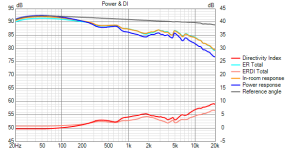
The mid is also my reference axis (ear level)
Some crazy things that VituixCAD2 can do- completely flatten a response to an arbitrary target. Here I chose to completely flatten the on axis @3m to be straight as a ruler (gray line)

Last edited:
In my way of thinking, the OP question is really about nominating those mid range drivers whose raw data indicates the potential for accurate and transparent performance. This should be a separate issue from the performance in any specific implementation in a passive or active crossover, since there will be too many other variables.
In my investigation of manufacturers data, the issue that is of most concern to me, is that typically 4-5" mid-range drivers have on-axis peaks in the range 5-10 kHz. The peak magnitudes can be 10 dB above the 1 kHz response magnitude. This implies that for a typical 2.5 kHz LR4 low pass crossover, the peak will be only 14 dB down from the 1 kHz output, rather than 24 dB down for a perfect driver.
Another concern is that the off-axis response typically shows significant unevenness in amplitude and phase response in the 5-10 kHz. For these reasons the integration with a tweeter may then be far from optimal.
I narrow down the mid range candidates by eliminating drivers that demonstrate such behaviour.
In my investigation of manufacturers data, the issue that is of most concern to me, is that typically 4-5" mid-range drivers have on-axis peaks in the range 5-10 kHz. The peak magnitudes can be 10 dB above the 1 kHz response magnitude. This implies that for a typical 2.5 kHz LR4 low pass crossover, the peak will be only 14 dB down from the 1 kHz output, rather than 24 dB down for a perfect driver.
Another concern is that the off-axis response typically shows significant unevenness in amplitude and phase response in the 5-10 kHz. For these reasons the integration with a tweeter may then be far from optimal.
I narrow down the mid range candidates by eliminating drivers that demonstrate such behaviour.
You can have also some trouble by rising distortion below the range 200-500Hz and after 3-5kHz and the last but not least surround resonnance in the usable range. Not always seen in the response but in distortion profile.
The MR13P is a typical example :
MR13P Audioxpress Test
I use the woofer version MW13P-8 as mid 380Hz-3kHz LR2, exhibit same behaviour as the mid version. It is one of my best speaker in the midrange.
The MR13P is a typical example :
MR13P Audioxpress Test
I use the woofer version MW13P-8 as mid 380Hz-3kHz LR2, exhibit same behaviour as the mid version. It is one of my best speaker in the midrange.
It is an old design from 2016/2017 ... the ZA14 from John Krutke will kill it anytime for a fraction of cost 🙂
https://www.madisoundspeakerstore.c...aph-audio-za14w08-5-aluminum-cone-mid/woofer/
Remember - what counts is how it sounds! Anyone out there for a shootout?
https://www.madisoundspeakerstore.c...aph-audio-za14w08-5-aluminum-cone-mid/woofer/
Remember - what counts is how it sounds! Anyone out there for a shootout?
The MR13P-8 is almost a perfect example of the issues I brought up my post #26 above. The MW13P-8 appears better behaved in the pass band 250 Hz-2.5 kHz. It has a smoother and more even response. They both have a similar response dip between 1 kHz and 1.5 k Hz. The MW13P-8 peakiness in the range 5-10 kHz is less severe than the MR13P-8 and would be my preferred choice of the two, especially if considering less steep low pass crossover slopes such as 12 or 6 dB/Octave.The MR13P is a typical example :
MR13P Audioxpress Test
I use the woofer version MW13P-8 as mid 380Hz-3kHz LR2, exhibit same behaviour as the mid version. It is one of my best speaker in the midrange.
https://sbacoustics.com/wp-content/uploads/2021/01/5in-SATORI-MR13P-8.pdf
https://sbacoustics.com/wp-content/uploads/2021/01/5in-SATORI-MW13P-8.pdf
I have had good results with monacor msh115hq, sph102kep and Visaton w100s in the range 300hz to 3.5Khz. However, I don’t have a reference high end drive and unit to compare these to. My main observation was that going 3 way active gives a dramatically improved sound over a simple and rather old passive 2 way.
Yes…..it is certainly EASIER to get a two way to behave with what has become ‘acceptable‘ compromise and I have submitted the caveat over and over that these systems all sound the same….. very polite with a smooth frequency response…..an audio ‘super smoothie’ so to speak…..overlap the at odds phase behavior of the two drivers right within the crossroads of the most sensitive passband of human hearing and greatest content of fundamental and harmonic music content…….this concoction is the recipe of the past 25 years of audio. It’s poured into the glass of an endless stream of mediocre content produced, mixed and mastered fast and furiously these days as record companies struggle to survive amongst collapsing revenue……..you better drink your fill and like it!In my way of thinking, the OP question is really about nominating those mid range drivers whose raw data indicates the potential for accurate and transparent performance. This should be a separate issue from the performance in any specific implementation in a passive or active crossover, since there will be too many other variables.
In my investigation of manufacturers data, the issue that is of most concern to me, is that typically 4-5" mid-range drivers have on-axis peaks in the range 5-10 kHz. The peak magnitudes can be 10 dB above the 1 kHz response magnitude. This implies that for a typical 2.5 kHz LR4 low pass crossover, the peak will be only 14 dB down from the 1 kHz output, rather than 24 dB down for a perfect driver.
Another concern is that the off-axis response typically shows significant unevenness in amplitude and phase response in the 5-10 kHz. For these reasons the integration with a tweeter may then be far from optimal.
I narrow down the mid range candidates by eliminating drivers that demonstrate such behaviour.
The way people listen to and consume music these days wasn‘t a happy accident……..it’s an epic artistic disaster where the classic 3way or midrange focused speaker is now the silenced and reviled critic. The midrange driver delivers the goods when a recording or performance aren’t good….it delivers all of the digital manipulations and instrumentation used in the process……it uncovers the mass market shroud of mediocrity. The fullrange crowd has known this for decades and since the ‘industry’ is no longer willing to accommodate them and their older, exquisite recordings created by the last of the titans, they’ve traded off nearly everything for that point source, midrange purity…..and they’re not wrong for doing it.
While we passionate few debate the midrange question, folks in the industry are feverishly implementing more AI into the process…..within 2 years you’ll have a nearly exclusive format of AI mastered content. Benign ‘boycotting’ of the industry only worsens the outcome…….the ‘happy accident’ of illegal file sharing that with the help of modern computing and private equity that has metasticized into the modern streaming platform…..a vile fountain of swill that dehydrates the natural creativity of those who’s artistry it exploits.
Last edited:
I have to ask. I have been told quite a few times, that 8" woofer duty up to around 6-800Hz, really do not require any exceptional driver. Something like as RS 225, SS Disco 22W, Seas L22 and SB CAC/NAC should all be very capable, at close to or 1,5x the price of your midrange unit.@mayhem13 Can you say more about your idea ?
For me your question is interesting to develop because things are not so simple 😉
I can give you a list of good mid-range at different price to 20$ to 400$ I have used and they work well.
I built several tree ways and I had some disappointing results. The problem are very diverse
1. I hadn't enough skills to understand how to do it right
2. The sound of the mid-range is not so good to my ears, where you use glass-fiber mid-range or a plastic with paper woofer.
3. Bad design
etc.
When you look a 3/4... ways you have this curve :
View attachment 1254616
Triade speaker
The mid-range fills a hole between the woofer and the tweeter ! In this case the slope are 24db/octave. You never listen to a mid-range, but a marriage of the driver. For me the problem is not the mid-range sound but how to you marry the mid-range 🙂
An other marriage, my own project : W22NX001+MU10RB+27DXT 800Hz-3500HZ LR2, not so easy to design but works well.
View attachment 1254621
Notes :
- With a mid-range I have the flattest response curve in my loudspeaker, better than a 2 ways where you can have serious issues in the frequency response 😉
- A 4" and a 5" for me are very different in crossover point.
- The problem with mid-range are power handling, when you play loud, the mid-range must not yelling.
So how did you come up with the extremely expensive W22NX001 ? It is more than 7 times more expensive than the midrange driver you use. And IMO, the midrange unit is often the one playing the most important spectrum of the entire frequency range - even though I do like very good quality bass.
That Seas driver is almost as expensive as the Purifi 8" 😳
Excellent question, why you marry this low cost mid range to this expensive woofer ?I have to ask. I have been told quite a few times, that 8" woofer duty up to around 6-800Hz, really do not require any exceptional driver. Something like as RS 225, SS Disco 22W, Seas L22 and SB CAC/NAC should all be very capable, at close to or 1,5x the price of your midrange unit.
So how did you come up with the extremely expensive W22NX001 ? It is more than 7 times more expensive than the midrange driver you use. And IMO, the midrange unit is often the one playing the most important spectrum of the entire frequency range - even though I do like very good quality bass.
That Seas driver is almost as expensive as the Purifi 8" 😳
1. I owned the first 8" magnesium driver W21EX002 and I was very happy with it. To my ears it is the best magnesium cone I heard at this dimension 8", the best neutral sounding 8" to my ears. I am not a fan of lower dimension of magnesium driver. I buy the latest version W22NX001 to replace my old W21EX002. I work a lot with this 8" magnesium driver and know well its limits. This new version W22NX001 is a very good driver, the motor is largely improve in the bass area. The midrange is as good, better as the older driver. The W22 is not good in bass < 160Hz but is exeptionnal to my ears in the "critical" midrange (160-1280Hz). I always found 8" doing things well with voices in this range of frequency.
I own other speakers with other 8" SS 22W8534, SICA 8H2CP and the magnesium 8" does better. But these other woofer works well, I like a lot the SICA 8".
2. To use it I need a tweeter that goes as low as 1500Hz/2000Hz. I tried the tweeter 27TAC but not convinced by the result. And I could go to a beryllium tweeter to handle the woofer at 1500Hz like the Jeff Bagby Helios speaker. But I think it is better to use a midrange and a tweeter 4"+1" instead a big 1" tweeter to handle 1500Hz. The combination 4"+1" is for me a good alternative, cheaper and better performance than a "big" 1" tweeter. Here I use the 4" in the upper midrange, lower/middle treble, not the area of a 8" which becomes very directive.
I would like to test this 8" with a 1" compression, it is in an other project.
At the end It took me time and listening test to have something satisfying to my ears. But it works very well ! I doesn't took a lot of risk, it looks a lot the mid combination of the Linktwiz LX521.
For those who think good audio material and very good midrange is useless. I don't think so. When you are a good musician, you need good material with good sound. Yes you can use technology but People are still going to concerts with real people and instruments.
So we’re going well beyond the 4 octave bandpass with the 8” woofer………for me regardless of the driver quality, something is compromised……and as you mention…..and 8” Wolfe that’s ‘ not good’ below 160hz……that’s an odd driver…..not even a fair representation of a midwoofer and at 8” not suitable for upper midrange directivity
Peerless 830870 PPB
https://ampslab-spk.com/2018/07/23/solitaire/
https://projectgallery.parts-express.com/uncategorized/tiny-tym/
https://diy.midwestaudio.club/discussion/1215/project-code-name-bilc
Here's what a 3 way with another 4" Peerless 830872 looks like,
(RIP) Lou's Braptor
https://www.rob-elder.com/LouC/speakers/Buyout/BravoxTower.html
https://ampslab-spk.com/2018/07/23/solitaire/
https://projectgallery.parts-express.com/uncategorized/tiny-tym/
https://diy.midwestaudio.club/discussion/1215/project-code-name-bilc
Here's what a 3 way with another 4" Peerless 830872 looks like,
(RIP) Lou's Braptor
https://www.rob-elder.com/LouC/speakers/Buyout/BravoxTower.html
Last edited:
We use those as helper bass drivers. Gets down to about 35 Hz, XOed at 250-350 Hz. Going up to 5k+ makes them easy to cross.
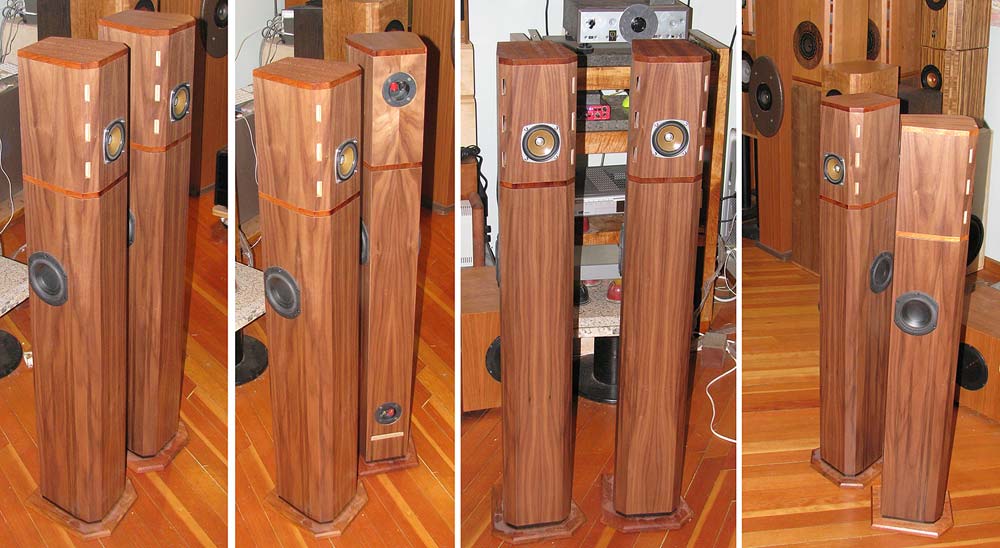
dave

dave
Good answer 👍Excellent question, why you marry this low cost mid range to this expensive woofer ?
1. I owned the first 8" magnesium driver W21EX002 and I was very happy with it. To my ears it is the best magnesium cone I heard at this dimension 8", the best neutral sounding 8" to my ears. I am not a fan of lower dimension of magnesium driver. I buy the latest version W22NX001 to replace my old W21EX002. I work a lot with this 8" magnesium driver and know well its limits. This new version W22NX001 is a very good driver, the motor is largely improve in the bass area. The midrange is as good, better as the older driver. The W22 is not good in bass < 160Hz but is exeptionnal to my ears in the "critical" midrange (160-1280Hz). I always found 8" doing things well with voices in this range of frequency.
I own other speakers with other 8" SS 22W8534, SICA 8H2CP and the magnesium 8" does better. But these other woofer works well, I like a lot the SICA 8".
2. To use it I need a tweeter that goes as low as 1500Hz/2000Hz. I tried the tweeter 27TAC but not convinced by the result. And I could go to a beryllium tweeter to handle the woofer at 1500Hz like the Jeff Bagby Helios speaker. But I think it is better to use a midrange and a tweeter 4"+1" instead a big 1" tweeter to handle 1500Hz. The combination 4"+1" is for me a good alternative, cheaper and better performance than a "big" 1" tweeter. Here I use the 4" in the upper midrange, lower/middle treble, not the area of a 8" which becomes very directive.
I would like to test this 8" with a 1" compression, it is in an other project.
At the end It took me time and listening test to have something satisfying to my ears. But it works very well ! I doesn't took a lot of risk, it looks a lot the mid combination of the Linktwiz LX521.
For those who think good audio material and very good midrange is useless. I don't think so. When you are a good musician, you need good material with good sound. Yes you can use technology but People are still going to concerts with real people and instruments.
I tried several midranges, ranging from Accuton 5", Dayton RS125 and SBMW13TX. The Satori was definitely the best from a broad perspective. It was smoother, clearer and easier to join with the Seas DXT I used. I also tried an SB 26ADC in an Augerpro waveguide, which worked like a charm. I'm in the KEF coax department now, and can't see myself leaving that sound anytime soon - simply so nice and coherent.
Now I just need some nice 8" woofers to sit around my Coax, to build something like the KEF R900. They will be crossed around 400Hz - which hopefully gives me a chance not to aim for the expensive Excel driver - even though I wish for best possible fidelity.
- Home
- Loudspeakers
- Multi-Way
- Your favorite 4-5” midrange driver?